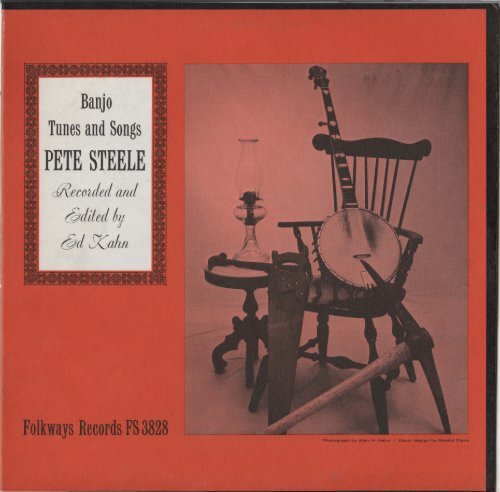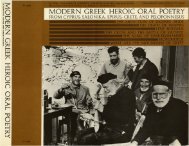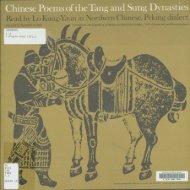PETE STEELE
PETE STEELE
PETE STEELE
Create successful ePaper yourself
Turn your PDF publications into a flip-book with our unique Google optimized e-Paper software.
FOLKWAYS RECORDS Album No. FS 3828<br />
©1958 Folkways Records & Service Corp., 43 W. 61st St., NYC USA 10023<br />
Notes by Ed Kahn<br />
It was early in the summer of 1957 that I first met<br />
Pete Steele and his wife, Lillie. A friend of mine,<br />
Arthur Rosenbaum, and I decided to drive over to<br />
Hamilton, OhiO, and try our luck at finding them.<br />
We both knew that for the past number of years the<br />
Steele family had been living in Hamilton; however,<br />
no one seemed quite sure how to get in touch with<br />
them, and moreover, no one that we knew of had<br />
visited them recently. After a few phone calls, we<br />
were able to find the Steele residence, and in a<br />
short time Pete Steele was singing and playing for<br />
us.<br />
On this first occasion, Pete used my banjo because<br />
he had recently sold his in order to buy a pistol.<br />
He said that he hadn't played for several months,<br />
but in a matter of minutes he was playing the instrumentals<br />
that had won him fame through his<br />
Library of Congress recordings. On that visit, we<br />
recorded much of the material on a small home recorder.<br />
In the last part of August, I was able to visit him<br />
again. It is from this session that the material<br />
in this album is taken. Although he hadn't yet<br />
purchased a banjo for himself, he had played other<br />
banjos with some regularity since "Ule time of our<br />
first visit. The time spent with the Steele has<br />
afforded experiences that I shall never forget;<br />
ranging from the fine cooking of Mrs. Steele to the<br />
music that was so often being made.<br />
To the folklorist, Pete Steele is a very interesting<br />
informant. He represents a strong tradition of the<br />
Kentucky hills, in its various traditions. Wherever<br />
he lived or viSited, he picked up songs, molded them<br />
into his own style, and yet preserved the essence<br />
of the material that he learned.<br />
Throughout his life, music has served a very strong<br />
function, perhaps stronger with Steele than other<br />
folk musicians being studied today. Because of his<br />
lack of formal education, he has had to rely on<br />
materials other than the printed page for the<br />
sources of both his musical material and for his entertainment.<br />
Music has always been a major source of entertainment<br />
for Pete Steele. Whether he is singing<br />
harmony with his wife, entertaining friends, or<br />
playing a complicated banjo instrumental, he is<br />
aware of his ability to Sing songs "the old way"<br />
and play almost anything on his instrument. It is<br />
perhaps the amazing versatility that he has on the<br />
banjo that has given him the most pleasure, for,<br />
unlike many other folk musicians, Steele has a<br />
great versatility of styles and techniques on his<br />
instrument.<br />
While most folk instrumentalists generally use one<br />
style, Steele uses many, deciding for each song<br />
which style will be the most effective. The right<br />
hand technique most often employed by Pete Steele<br />
is a type of double thumbing with an occasional<br />
pinch of the first and fifth strings in order to<br />
add syncopation. This style is clearly heard on<br />
"Ellen Smith" and "Pretty Polly."<br />
In addition to this style, Pete Steele also use&<br />
a standard "up-pick" style. This can be heard on<br />
"Last Payday at Coal Creek." On many of 'the faster<br />
numbers he prefers frailing and "double noting" or<br />
double thumbing. This style is well illustrated<br />
by his renditions of "Shady Grove" and "Goin' Round<br />
this World, Baby Mine. "<br />
In all of these styles, Steele uses only his fore<br />
finger and thumb. To add to the versatility<br />
already achieved in his right hand, he uses as<br />
wide a variety of tunings as the individual songs<br />
may demand. The effects achieved are perhaps<br />
best shown in "Little Birdie" and "Train-Pullin'<br />
the Crooked Hill."<br />
Pete Steele was born in the small town of<br />
Woodbine, Kentucky, on March 5, 1891. It was<br />
in this area, frbm his father and people that<br />
he met, that he began to learn songs and the<br />
techniques of playing the five string banjo.<br />
" ••• at six years old, my father made a small<br />
banjo. He took a sieve and put a squirrel's<br />
hide on for the banjo head; put thread strings<br />
on it and that's how I learned to play a banjo.<br />
My father was a violin player ••• one of the<br />
best, I think ••• I learned most of my banjo<br />
pieces from him. We had lots of good times<br />
together playing music at the last days of<br />
schools and at box suppers and so on. And when<br />
I think of those good times we had together,<br />
I get to feeling very sad, wishing we could be<br />
together and live them days over •••• "<br />
At the age of nineteen, Mr. Steele married<br />
Lillie Swanner. Miss Swanner was born in<br />
Pittsburg, Kentucky, but at the age of six<br />
her family moved to London, Kentucky, where<br />
her father bought a farm. Of London, she<br />
remembers: " ••• I worked with my father in<br />
the fields as my brothers were much younger<br />
and not yet old enough to work. At the age<br />
of sixteen I got married ••• :'<br />
After their marriage, they lived in various<br />
parts of Kentucky, Indiana, and Ohio, where<br />
Mr. Steele worked at jobs ranging from<br />
carpentering to making staves for whiskey<br />
barrels, and back to farming, his original<br />
occupation. Probably the most formative years<br />
for the Steeles, from a folk music point of<br />
view, were the eighteen years they spent in<br />
Harlan County where Pete worked in various<br />
coal mines. From Harlan County, they moved<br />
to Indianapolis, Indiana, for a few years,<br />
and then back to Laurel County, Kentucky, where<br />
both Pete and Lillie Steele had spent their<br />
childhoods. Of East Bernstadt, in Laurel County,<br />
Pete remembers: " ••• there I played my banjo<br />
for our neighbors to square dance. We would<br />
all meet at one neighbor house one Saturday<br />
night and the next Saturday night at another<br />
house .••• II<br />
After leaving East Bernstadt, they moved to<br />
Hamilton, OhiO, where they have lived since<br />
1937. In 1938 Alan Lomax recorded the Steeles<br />
for the Library of Congress Folk Music Archives.
Although more than. thirty recordings were made,<br />
only a few of these have been made available<br />
to the public through records issued by the<br />
Library.<br />
The purpose of this album is to make generally<br />
available same of the more than two score songs<br />
that they have been singing in their family for<br />
years, and :fUrthermore, to offer comparative<br />
material for those interested in studying the<br />
musical tradition of one family over many years.<br />
In the following notes, I have indicated Library<br />
of Congress archive numbers for those songs that<br />
are depesi ted in the Library.<br />
NOTES ON THE SONGS ---------<br />
SIDE I, Band 1: ELLEN SKITH<br />
------<br />
In 1893 Peter De Graff was convicted of the murder<br />
of Ellen Smith. As a result, several local<br />
murder ballads gained currency. Today, there are<br />
two slightly different ballads of Ellen Smith.<br />
In one, the narrator admits killing her, and in<br />
the other pleads that he has been accused of a<br />
crime which he did not commit. Steele introduces<br />
his version by saying: "The song of 'Ellen Smith, '<br />
and it was a boy that took the punishment of<br />
some other man's crime." The tune closely<br />
resembles the religious song "How Firm a Foundation. "<br />
Steele learned this version from Andy Whitaker, of·<br />
Shelbyville, Kentucky. I was unable to locate<br />
Mr. Whitaker or find anyone who knew of him or his<br />
family.<br />
References:<br />
Brown II, pp. 714-717<br />
Brown IV, pp. 326-327<br />
Combs, pp. 219-222<br />
Fuson, p. 132<br />
Laws NAB, pp. 190-191<br />
Richardson, pp. 32-33<br />
MFS, 1707 B<br />
"Ellen Smith"<br />
Oh, it's poor Ellen Smith<br />
This poor girl she was found<br />
With a ball through her heart,<br />
Lying cold upon the ground.<br />
I was saw on Friday,<br />
Before that sad day,<br />
They picked up her cold body<br />
And carried hit away.<br />
Oh, they gathered their Winchesters,<br />
They chased me all around,<br />
They found this poor boy<br />
In the :fUr edge of town.<br />
Oh, they send me to Frank:fUrt<br />
I've been there before,<br />
I wore the ball and chain<br />
Till it made m:r ankles sore.<br />
I courted her through years<br />
For to make her m:r wife,<br />
I loved her too dearly<br />
To take her precious life.<br />
Some day before long<br />
We'll stand before the bars,<br />
And when God tries our case,<br />
We'll shine like a star.<br />
SIDE I, Band 2: LITl'LE BIRDIE ------<br />
Lyric songs of the folk singer have often<br />
centered about the carefree life of the little<br />
bird. In "Little Birdie," a lonesome person<br />
longs for the advantages of the little bird's<br />
life. Although I have heard this song sung<br />
many times, the only printed text which I can<br />
find is in Randolph (I, pp. 121-122). His<br />
text, under the title "The Dark Hollow," has<br />
three stanzas which bear a close resemblance<br />
to "Little Birdie" as I have heard it sung.<br />
Steele's version, while maintaining essentially<br />
the same tune which Randolph gives, differs<br />
textually from the printed version. Steele<br />
learned this version from Jesse Herald of<br />
Kentucky.<br />
References:<br />
Randolph, I, pp. 121-122<br />
MFS, 1694 Al<br />
"Little Birdie"<br />
Little birdie, little birdie,<br />
Come sing your song to lIIej<br />
For I am so lonesome,<br />
Lonesome as can be.<br />
Pretty birdie, pretty birdie,<br />
What makes you :fly so high?<br />
You must have another true love<br />
Far up in the blue sky.<br />
Wish I was a little birdie,<br />
I'd not build m:r nest in the air,<br />
Build m:r nest in m:r true love's breast,<br />
And steal the locks of her hair.<br />
There's a place called heaven, boys,<br />
A place where them angels dwellj<br />
There's a place of paradise,<br />
But there's no place like Hell.<br />
SIDE I, Band 3: THE TRAIN A-PULLIN'<br />
THE CROOKED HILL<br />
Banjo players have long loved to immi tate the<br />
sounds of life around them. The train has been<br />
an extremely popular starting point for many of<br />
these instrumentals. Steele learned this complicated<br />
instrumental from Andy Whitaker. He<br />
tunes his banjo to DCGCE, from first to fifth<br />
string.<br />
Reference:<br />
MFS, 1704 B2<br />
SIDE I, Band 4: INTERVIEW AND RELIGIOUS SONGS<br />
Folk belief has long had it that the banjo, as<br />
well as other stringed instruments, is the<br />
devil's ins trument (see Brown I, p. 97). Pete<br />
Steele's answer to the question concerning the<br />
banjo as the devil's instrument represents a<br />
general easing of former restrictions placed on<br />
"religious" people. Steele considers religion<br />
and the music of stringed instruments to be completely<br />
compatible. The Steeles' singing of<br />
religious material also shows a family tradition<br />
that they still enjoy.




